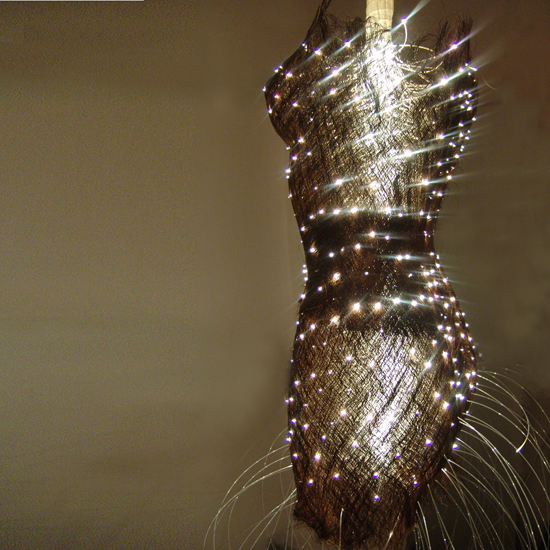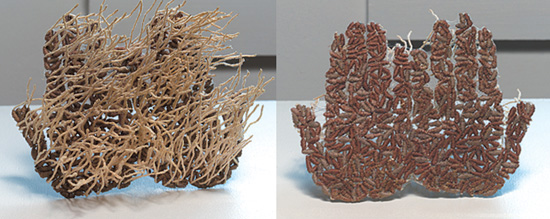In 2011, Artist Anda Klancic participated in the exhibition Energheia Miniartextil presenting the work Aura F & M in the former church of San Francesco in Como, Italy. The exhibition traveled to Milan, Venice and Montrouge in the suburbs of Paris. The excerpt below is from an interview with Olga Damiani in Arte & Arte, May 2012, http://www.miniartextil.it/news_press.php, translated with the help of the artist, Google and browngrotta arts:
“It seems to me that in contemporary art, which rightly includes textile art, the value should be appreciated by the innovative content of the work, not by conformity with measures required and antiquated techniques. Miniartextil has the great merit of being able to pass these strict limits….I used optical fiber and fiber from the bark of palm for Aura F & M, but the research of artificial equipment and plant material, necessary for the work, was not my main thought. The choice of suitable materials was conditioned by the demands of expression. With Aura F & M I have chiefly tried to express in form of an objective construction the theme Energheia, that was proposed for this Miniartextil. I wanted to show the vital energy in the human species: the light, connected across from man to the earth and the universe, has the rhythm of breath, feeling of life. By creating this strong expressive content, communications that I consider important for humanity, I thought about various properties and the quality of the work submitted at different levels. At the first level, I inserted the shape and movement of light, as a pleasant, fresh element, one that may fail to attract the viewer’s eye in a social environment where people are bombarded at every turn by visual and audio advertising and information disequilibrium. In the second level, I tried to arouse in the viewer memories of distant experiences and thoughts of wisdom forgotten in quiet, and in doing so to create mnemonic associations in the present. The choice of materials can also be understood as a metaphor: the products are technological, they represent rationality combined with artistic intuition inherent in organic materials, again, used in order to induce subconscious associations. The diversity of rhythms lighting the two bodies, with the sources of halogen light obscured at various points, also contributes to a second level of meaning. It creates a metaphor for everyday life, that man and woman are rarely both in the light at the same moment, opening a window on the primordial difference between the sexes.”


